The U.S. Air Force has deployed a contingent of F-15C Eagle fighter jets to the Middle East, sending them on their way carrying live missiles. This follows the arrival of four B-52H Stratofortress bombers and the early appearance in the Persian Gulf of the Nimitz-class aircraft carrier USS Abraham Lincoln and her strike group, all ostensibly in response to still largely unclarified threats to American forces in the region from Iran and its proxies.
On May 9, 2018, Air Forces Central Command announced the arrival of the F-15Cs, which had occurred the day before, but offered few details, simply releasing photos showing two Eagles from the 48th Fighter Wing based at RAF Lakenheath in the United Kingdom taxing at an “undisclosed location” in Southwest Asia. One of the planes in the carried the name Deadpool, a reference to the Marvel Comics anti-hero, while the other had the nickname “Starscream” and the logo of the Decepticons, the villains of Transformers franchise, which involves sentient robots that can transform into various vehicles and aircraft. Starscream originally had the ability to transform into the likeness of an F-15. It is unclear how many Eagles the Air Force has deployed to the Middle East or may be planning to send in the near future.
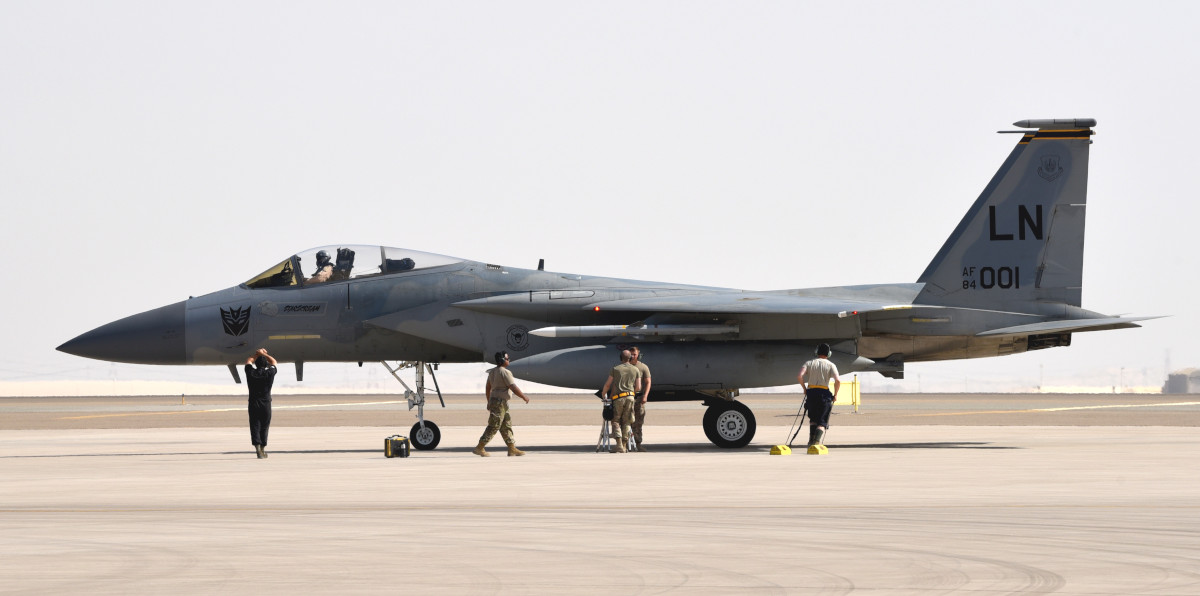
The released pictures also showed that the planes were carrying live weapon loads consisting of 6 AIM-120C Advanced Medium-Range Air-to-Air Missiles (AMRAAM) and a pair of AIM-9X Sidewinder close-in dogfighting missiles. They also each carried an AN/AAQ-33 Sniper Advanced Targeting Pod (ATP) on the centerline, which offers a long-range visual identification capability for the F-15C, which you can read about more here.
“U.S. Air Force fighter squadrons enhance regional partnerships and demonstrate a continued commitment to regional security and stability,” a caption to one of the photographs read. “These aircraft were moved within the theater to be best positioned to defend U.S. forces and interests in the region.”
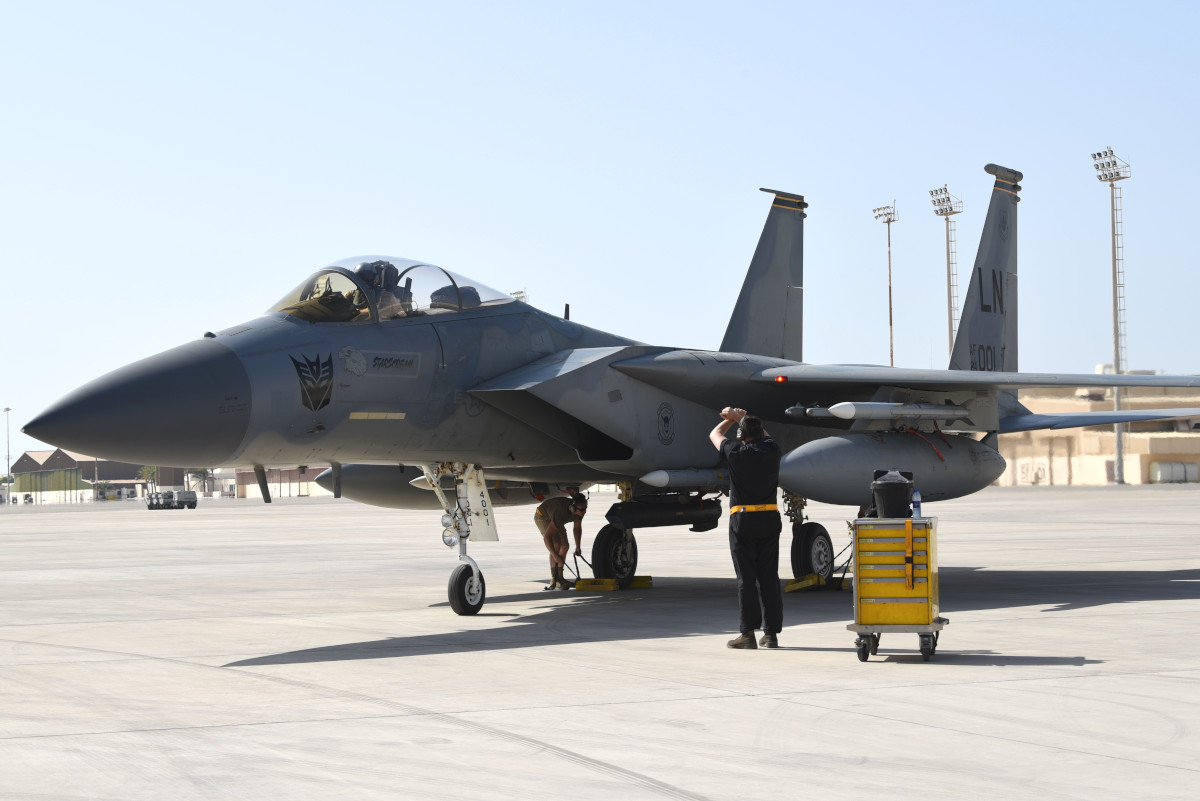
It is worth noting that in February 2019, the Air Force withdrew a contingent of F-22 Raptor stealth fighters from Al Dhafra Air Base in the United Arab Emirates and replaced them with F-15Cs. Two months later, the Air Force F-35A Joint Strike Fighters arrived at that same base marking the first time the service had operationally deployed these stealthy jets to the Middle East, but not as a replacement for the Eagles. As with other recent force deployments to the region, it is unclear as yet as to whether the deployment of the additional Eagles had already been scheduled to make a trip to the Middle East well in advance.
Also on May 9, 2019, two additional B-52Hs from the 2nd Bomb Wing at Barksdale Air Force Base in Louisana arrived at Al Udeid Air Base, Qatar, bringing the total number of the bombers there to four. The first pair had begun their deployment two days earlier.
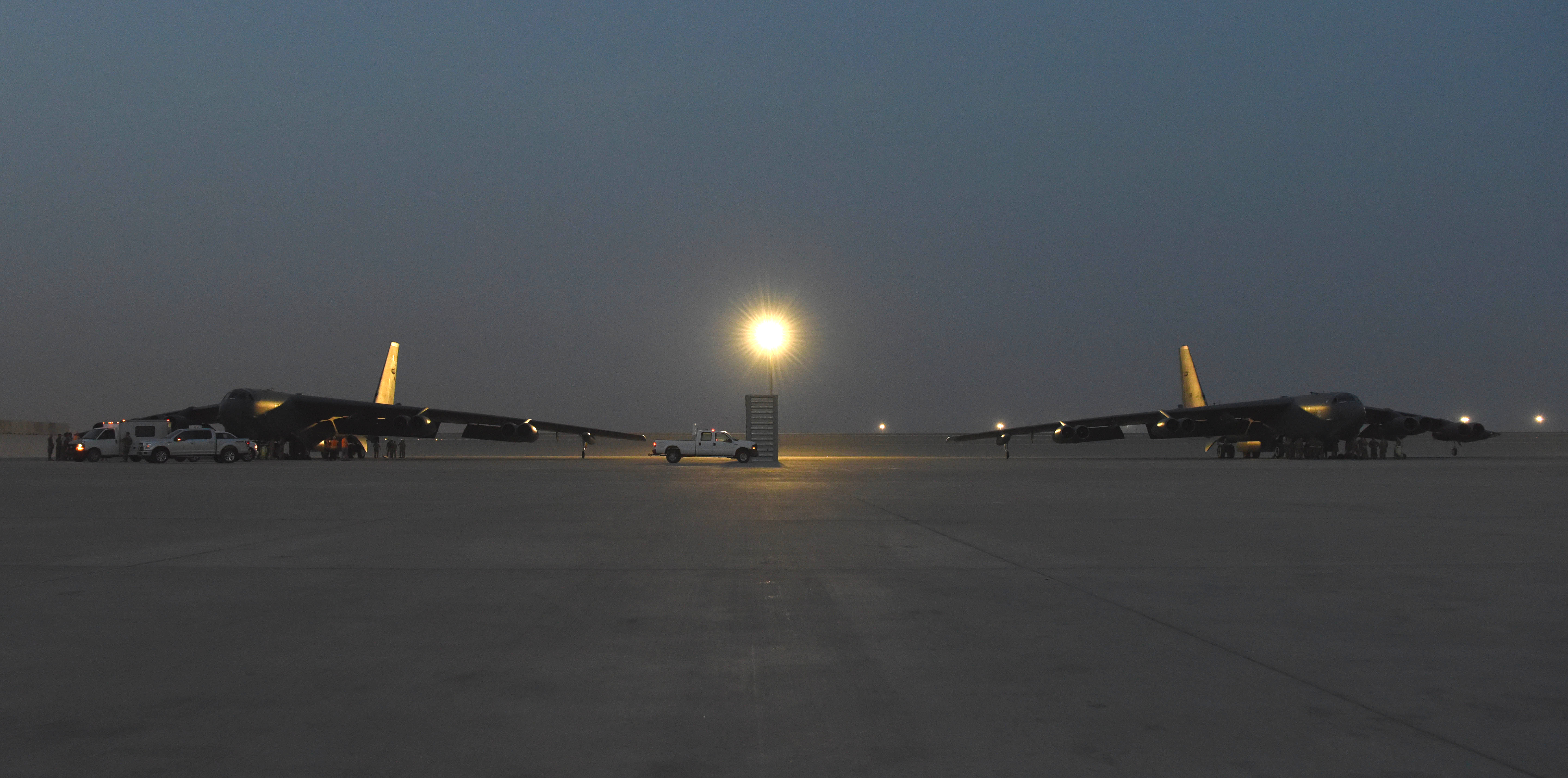
The USS Abraham Lincoln, and her associated strike group, is still sailing toward the Persian Gulf, transiting through the Red Sea on May 9, 2019. The carrier strike group was scheduled to deploy to the region, but after first conducting various activities in the Mediterranean Sea. On May 6, 2019, a statement from National Security Advisor John Bolton had announced that the ships would instead go directly to the Middle East.
Separately, online plane spotters have noticed a recent flow of C-130 Hercules cargo aircraft from Europe heading toward the Persian Gulf, but it is unclear whether or not this is related to the recent deployments of aircraft and ships. The Air Force had only recently withdrawn B-1 Bone bombers from Al Udied and did so without any immediate plans for any new bombers to arrive to take their place.
It could be that the service now needs to bring back a variety of personnel and supporting equipment again to sustain the new bomber operations. They could also be supporting the arrival of the F-15s from the United Kingdom or some entirely separate mission.
The buildup is officially in response to intelligence that showed unspecified threats from Iran and its various regional proxies against American forces throughout the Middle East. Since Bolton’s initial announcement, media reports, citing unnamed sources have suggested that the intelligence came by way of Israel and that it involved details about the movement of ballistic missiles in the region by sea.
It remains unclear who actually has been responding to who and whether or not Iran only began making its moves in the first place in response to U.S. actions. Tensions between the United States and Iran have already been steadily building in recent months. Notably, in April 2019, the U.S. government designated all of Iran’s powerful quasi-military Islamic Revolutionary Guard Corps (IRGC) a terrorist organization, heaping even more sanctions on top of the group, which has ties to Iran’s controversial nuclear and ballistic missile programs, as well as international militant and terrorist networks. In response, Iran designated all U.S. military forces in the Middle East as terrorists, a largely symbolic gesture.
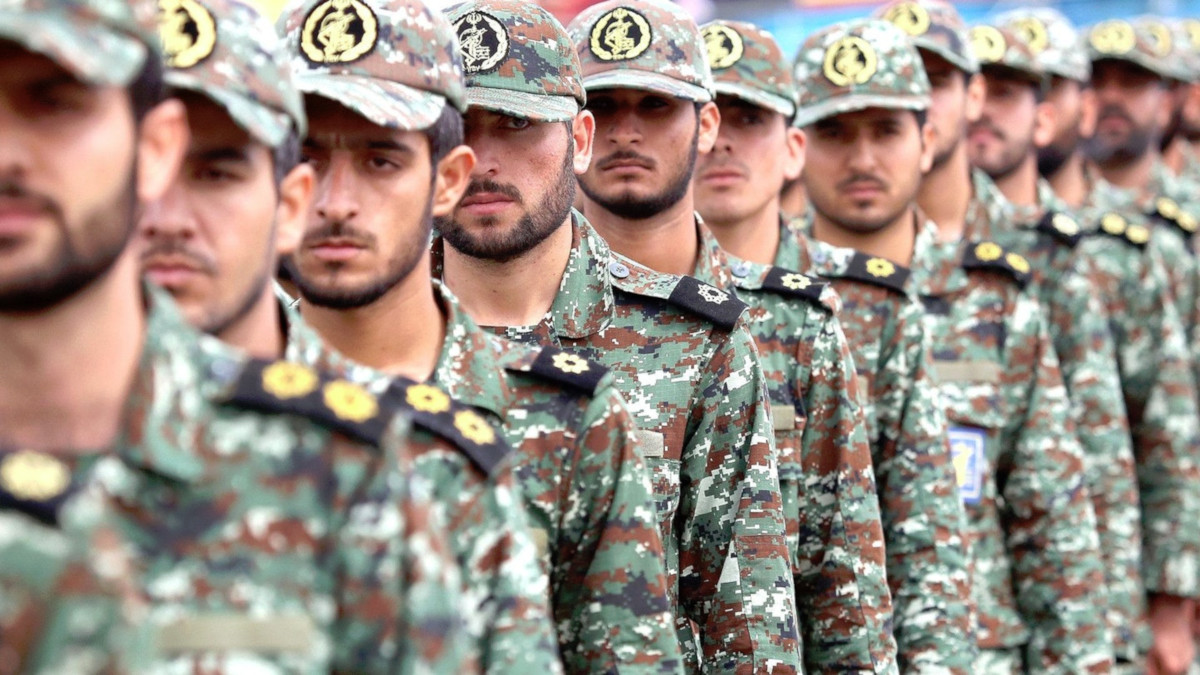
Official statements from the Trump Administration, including Trump himself, have offered little additional clarity on the situation and the scope of the potential threats and just how imminent, or not, they actually are or might be. Iran, has, unsurprisingly, categorically denied the accusations, but its hostile position to the United States and its regional allies is no secret, nor is the fact that it supports a variety of terrorist and militant groups throughout the Middle East and elsewhere, who have targeted Americans and their allies over the years.
“The Islamic Republic of Iran has engaged in an escalating series of threatening actions and statements in recent weeks. The response of the United States and our partners and allies has been clear: We do not seek war,” Secretary of State Mike Pompeo wrote in a statement on May 9, 2019. “The regime in Tehran should understand that any attacks by them or their proxies of any identity against U.S. interests or citizens will be answered with a swift and decisive U.S. response.”
At the same time, there is also no evidence, so far, that it, or its proxies, have made any new or particularly provocative moves as the U.S. government asserts. Some reports have suggested that American officials may be misinterpreting the intelligence and making whatever Iran is or isn’t doing out to be more an imminent concern than it actually is. In a May 9, 2019 interview with MSNBC, Iranian Ambassador to the United Nations Majid Takht Ravanchi specifically drew comparisons to the deliberate manipulation of intelligence in the run-up to the U.S.-led invasion of Iraq in 2003.
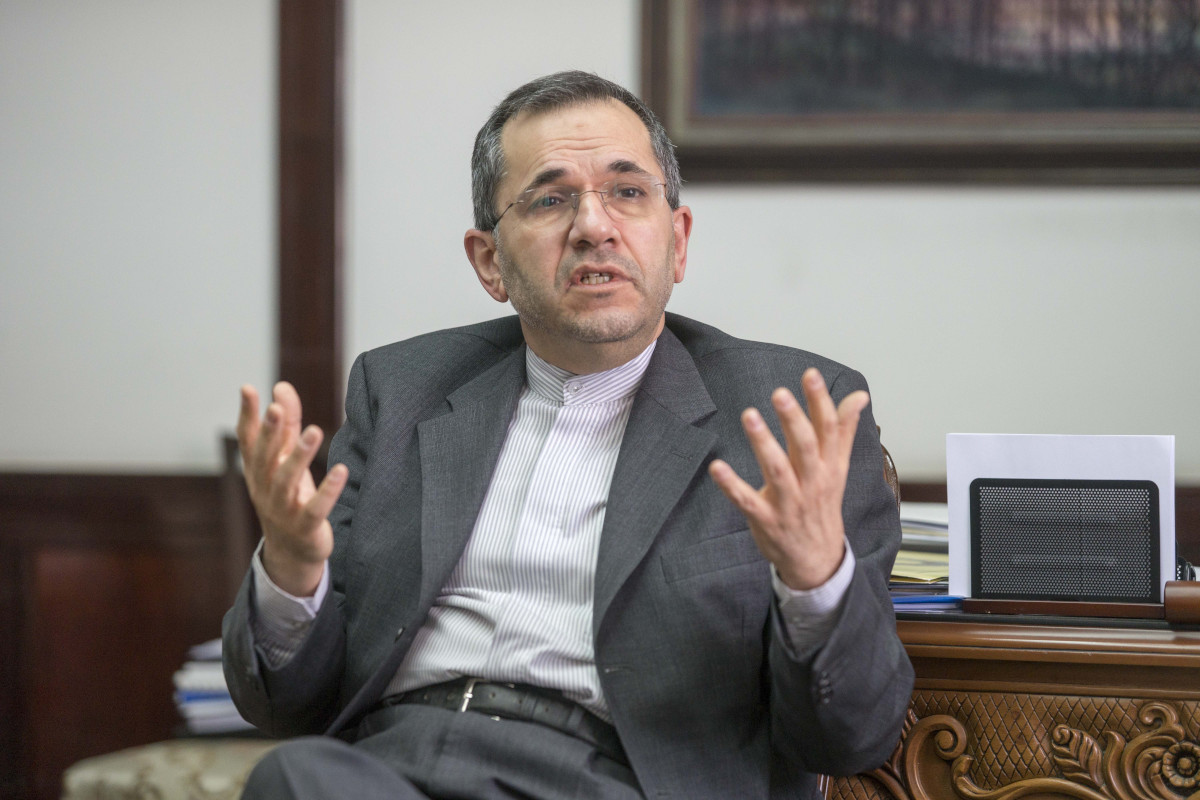
The mixed messaging goes beyond the military domain, as well. On May 8, 2019, the Trump Administration his Iran’s metal industries with all new sanctions. This goes beyond the oil and other sanctions that had come back into force after Trump pulled out of the controversial Iran Deal over that country’s nuclear program in 2018. But the next day, the President took a more diplomatic tone, noting that he was often the one to “temper” National Security Advisor Bolton’s hawkish impulses.
“What I’d like to see with Iran, I’d like to see them call me,” Trump told reporters on May 9, 2019. “We just don’t want them to have nuclear weapons – not too much to ask. And we would help put them back to great shape.”
It should be noted that the Iran Deal, formally known as the Joint Comprehensive Plan of Action (JCPOA), did put in place provisions that had prevented Iran from building nuclear weapons. All of the parties, including the United States, agreed that Iran was complying with this deal. The Trump Administration pulled out of the agreement based largely on the argument that it did not cover other worrisome activities, such as ballistic missile development, support for international terrorism, and domestic human rights in Iran.
“No talks will be held with the Americans, and the Americans will not dare take military action against us,” Yadollah Javani, the IRGC’s deputy head for political affairs, told the semi-official Tasnim news outlet in Iran on May 10, 2019. “Our nation… sees America as unreliable.”
The growing concern now is that miscalculations and miscommunication from both the United States and Iran could lead them to stumble into a larger conflagration, one that could also potentially set off proxy conflicts in other countries where Iran has significant influence. Hardline elements in the country have now called for attacks on the Abraham Lincoln. There are been renewed threats to blockade the immensely important Strait of Hormuz, as well, which would have worldwide repercussions.
But these rhetorical threats are well in line with years of Iranian posturing and bluster, which, so far, has yet to lead to actual major actions on their part, despite flamboyant military displays, including the destruction of a mock aircraft carrier during an exercise in 2015. Any conflict between the United States and Iran would be protracted and brutal, but it seems hard to see how the Iranian military could actually win a stand-up fight against its American counterparts and, by and large, they seem to know it. Going as far as to close off the Strait of Hormuz could easily do as much, if not more damage, to Iran’s economy as anyone else.

Iran’s very real capabilities, including shore-launched anti-ship cruise missiles, ballistic missiles that may have anti-ship capabilities, naval mines, submarines, small manned and unmanned boats able to conduct swarming attacks, and more, are more intended to make the price the United States would have to pay in any conflict too unbearable to contemplate. This is all bolstered by the added threat of cyber attacks or the use of proxies to conduct terrorist attacks far from any battlefield.
All told, the entire situation seems as nebulous as ever. Trump’s comments regarding Bolton only seem to fuel the previous speculation that the National Security Advisor might be trying to goad Iran into responding and providing a pretext for a more forceful American response.
“[Bolton] has strong views on things, but that’s O.K,” Trump said on May 9, 2019. “I have John Bolton and I have other people who are a little more dovish and ultimately I make the decision.”
So far, this exchange of ideas in the White House has led to a surge of U.S. forces into the Middle East, but with little apparent explanation as to their ultimate purpose.
Update: 5:55pm EST—
Voice Of America has reported a new set of force changes and deployments to the Middle East. This includes the arrival of the San Antonio-class landing platform dock amphibious ship USS Arlington in the Persian Gulf and the U.S. Army sending a Patriot surface-to-air missile battery to an undisclosed location.
“USS Arlington will be replacing the USS Fort McHenry already in the region,” VOA Carla Babb Tweeted out. “It will be providing additional command and control capability in the region, says sr. military official. Would not say where Patriot is being deployed.”
USS Arlington and USS Fort McHenry are both part of the Kearsarge Amphibious Ready Group, which also includes the Wasp-class amphibious assault ship USS Kearsarge and the 22nd Marine Expeditionary Unit. That Arlington was not already in the Persian Gulf with Kearsarge actually points to that ship potentially having been operating off the coast of Libya, where U.S. Marines landed in early April 2019 to help other American personnel evacuate in the face of heavy fighting in and around the country’s capital Tripoli. If Fort McHenry is now leaving, that ship may be moving back into the Mediterranean to take up station off Libya, where things also remain very much in flux.
The U.S. military had Patriot missile units deployed in Bahrain, Kuwait, and Jordan until withdrawing them in late 2018 to meet order to reposition them to be better aligned with the Pentagon’s renewed focus on a potential large-scale conflict with a major opponent, such as Russia or China. The redeployment of a single battery would not return the United States to the posture it had had last year, though the U.S. military could decide to deploy additional systems in the near future.
Contact the author: jtrevithickpr@gmail.com
